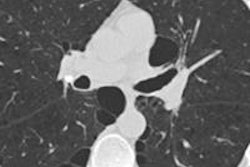
Quantitative analysis of CT scans revealed that long-term exposure to everyday air pollutants was associated with worsening lung function and faster progression of lung disease in otherwise healthy individuals in a new study, published online August 13 in the Journal of the American Medical Association.
Emissions from motor vehicles and industrial facilities can expose people to a complex mixture of air pollutants that holds major risk for respiratory health problems and death, especially in high concentrations, noted corresponding author Dr. Joel Kaufman from the University of Washington and colleagues. The effect of long-term exposure to low levels of air pollution commonly present in major cities is less understood.
In the current research, the group examined the data of 7,071 individuals from six U.S. cities who participated in the Multi-Ethnic Study of Atherosclerosis (MESA) air and lung studies. All of the participants underwent a baseline chest CT scan between 2000 and 2002, and most received at least one follow-up cardiac or lung CT scan by 2018.
The researchers estimated the participants' exposure levels to several different air pollutants -- including ambient ozone (O3), fine particles (PM2.5), nitric oxide and dioxide (NOx), and black carbon -- based on measurements obtained through cohort-specific monitoring and from the U.S. Environmental Protection Agency air quality system database.
They also calculated the participants' percent emphysema, or the proportion of lung pixels less than -950 Hounsfield units present on their CT scans. The participants' median percent emphysema was 3% on the baseline CT exams and increased at an average rate of 0.58 percentage points over 10 years.
Over a median period of 10 years, Kaufman and colleagues found statistically significant associations between greater exposure to each one of the air pollutants and worsening lung health. For example, individuals exposed to higher concentrations of PM2.5 and NOx at baseline ended up having greater emphysema progression. Exposure to higher concentrations of O3 also led to increased emphysema progression, as well as greater declines in lung structure and function on spirometry tests.
| Association between exposure to air pollutants and emphysema on CT | |
| Annual increase in percent emphysema | |
| O3 (per 3 parts per billion) | 0.13 |
| PM2.5 (per 2 µg/m3) | 0.11 |
| Black carbon (per 2 µg/m3) | 0.1 |
| NOx (per 10 parts per billion) | 0.06 |
What's more, the negative effects of air pollution exposure were even more pronounced among current smokers, likely due to the additive effects of smoking on airway inflammation and oxidative stress, the group noted.
The researchers additionally observed a slight decrease in PM2.5 and NOx concentrations over the 18-year study period. They suggested that recent regulations set forth to reduce air pollution in the U.S. may have contributed to this trend, although overall concentrations of O3 during the same time window conversely increased.
"Because long-term concentrations of O3 at current levels were strongly and consistently associated with both progression of emphysema and decline in lung function in this study, more effective control strategies to reduce O3 concentrations may be needed to protect lung health," they concluded.




















